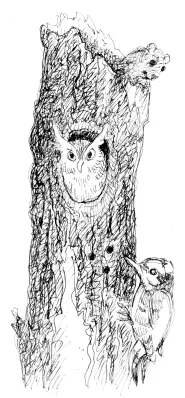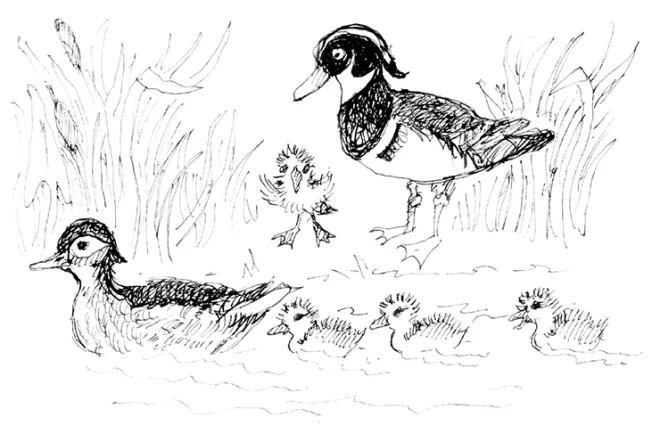
Snags are dead trees left standing, which is the way of the world in the woods, but not in the American landscape, where imitation of Disney World plant sculptures is the desired ideal (until the homeowner finds out how much work it is to maintain a topiary of Uncle Scrooge). When most people have trees taken down they have three options: cut the tree down and have the stump pulled (the most expensive option, but the only one that allows immediate replanting); cut the tree down and have the top of the stump “ground down” (less expensive, but really annoying when the homeowner realizes they can’t plant anything in its place because there’s a giant wooden plug in the ground); and cutting most of the tree down but leaving a six- to ten-foot “snag” standing (the cheapest option, and the best for wildlife).
A couple ten years ago I had a bunch of dead trees taken down, including a magnificent double-trunked ash that had fallen prey to the emerald ash borer, an invasive, nasty, non-native insect that is sending ash trees the way of the American elm and chestnut. I take this VERY personally as ash is THE best wood for making professional baseball bats. Hickory is also very good, but not used very much in this modern era as it is too heavy for millionaires to swing.
Today’s bats generally weigh between 33 and 35 ounces. Babe Ruth and Shoeless Joe Jackson both used bats that weighed over 40 ounces, which doesn’t sound like much until you try and swing one. (The heaviest on record was 44 ounces, which was illegal then and now, but if you’re the umpire are you going to argue with The Babe or Shoeless Joe?) Phillies slugger and fan favorite of the 1970s Dick Allen reportedly often used a 50-ounce bat, depending on who was umpiring home plate that day. He also hit the longest homers in the history of Shibe Park/Connie Mack stadium. (“All that ball needs is a stewardess and an in-flight movie!”) Those bats were turned using ash or hickory.

But today’s most popular choice—maple—is why major league players go through so many bats a season: maple bats are light, but shatter VERY easily, an excellent reason not to look at your phone if your seats are in the “dish” (a select group of seats closest to home plate where you have the best chance of “catching” a souvenir that is trying to impale you).
At any rate, I instructed the tree crew to leave each tree a snag, and they insisted they knew what that meant. At the end of the day, I went out to see that the double-trunked ash was cut down to about half its original size, which meant it was still higher than the house. The crew chief (and owner of the company) didn’t look like he was feeling good but said they’d come back to finish up.
Well, it’s long past “later on,” and luckily I am happy with my too-tall snags, especially the ash, which is riddled with woodpecker holes high up the trunk. We have also seen a tiny owl living in a hole lower to the ground, and several mysterious holes near the bottom of the tree, which we don’t want to mess with.
So there it stands, an obvious home for lots of wildlife (as are the other snags). But a wildlife experience I had early in Spring topped them all. It was during a too-early heat wave, so I got up at 6 a.m. to water and check on things. The day before had been French Foreign Legion hot and dry, but at 6 a.m., it was delightful! A pleasure to be outside, as it would NOT be by noon that day. So I was watering plants and generally puttering around in the cool dry air when I heard a weird sound.
You know how Evil Squirrels love to taunt you with their high-pitched chuckling from the trees? This sound was similar but much deeper in tone. It was definitely coming from the trees, but sounded more like an Evil Bullfrog than an Evil Squirrel. I was able to isolate it to the top of one arm of the double-trunked ex-ash, but couldn’t see anything. Then something popped out of the obviously hollow top.
The mystery guest went back inside and then popped up again: a sequence that was repeated over and over as I stared and wished I had brought my coffee outside. It peeked out of the hole at the top slowly, each time revealing a little more of itself. Then I saw a duck bill! “I tawt I taw a duck,” I mumbled in my best Tweety Pie voice. Then, as if on a hidden riser, it slowly moved upwards until I could see its entire body. “I did, I did; I did taw a duck!” It sat there for a moment, and then took off, a duck of many colors, gliding gracefully low through the woods across the road. Was this a poor mallard that didn’t make it home last night and took refuge in what had become the neighborhood’s Motel Six? Or was it some other crazily colored canard?
I found a great online article from Cornell (the exact site is called “All About Birds,” without any spacing [of course; who made these rules?!]), listing the 20 most common ducks in Pennsylvania, with loads of great photos. The first nine were no-go’s: “No, that’s not it; no, not it either…” until I got to number 10—the wood duck! (How much wood would a wood duck chuck if a wood duck could chuck wood? Plenty, it turns out!)

I quote: “Unlike most waterfowl, wood ducks perch and nest in trees and are comfortable flying through woods. Their broad tail and short, broad wings help make them maneuverable.” They even call them “cavity nesters.” A duck nest in the top of my already favorite snag? Will I see little wood ducklings at some point?
Another Cornell article made that possible sighting much more interesting than I had hoped for. Apparently when Huey, Dewey, and Louie emerge on their first day out of the shell, “they jump out of the tree and fly.” Yikes!
But the season (“in like a lion, out like Godzilla”) continued to be hot in the extreme, and so I had a lot of 6 a.m. opportunities to be out, but nothing, nada, bupkis. Then, towards the end of the month, I saw activity at thetop of the tree! Feathers visible, climbing noises…then a pair of non-ducks climb out at the exact same spot and quickly fly away. Try as I might, I could not ID them; they were fairly large (much larger than a tree sparrow, but smaller than a goose—which would be interesting to see rising up from the center of a tree; isn’t that in a ballet or something?). I’m pretty sure they were grey and white—male and female the same colors (unless it was two guys leaving a late-night card game or two females who had come to break up the game). But seeing something totally unexpected (again!) flying out of the top of the tree froze me, so I can give no more clues. (And if YOU know, remember—you have to answer in the form of a question.)
What do I think happened? We have three families of red-tailed hawks nesting in the deep woods at the back of our property. Red-tailed hawks are the primary predator of wood ducks. This explains the bobbing head action the day my wood duck slowly emerged. I’m guessing he had picked this spot to nest, but then saw a red tail or five. So on “my” morning, he popped up to check the skies a couple of times to make sure they were clear and then got out of Dodge ASAP. (I bet YOU thought I was going to say something else very sad, but there would [wood?] be evidence left behind had the worst happened, so I presume he made a clean getaway.)
I really like to sleep in and need a good reason to stop scream-ing “c’mon—just ten more minutes!” at my alarm. In the past that was only on a day that would hit 90 by noon. Now it’s in the hope of seeing our latest early-morning guest stars—Mr. and Ms. Grey And White—rise from the penthouse. While waiting for that to happen, I’ve been practicing my best Monty Hall impression so I can yell, “Come on down!” ❖



